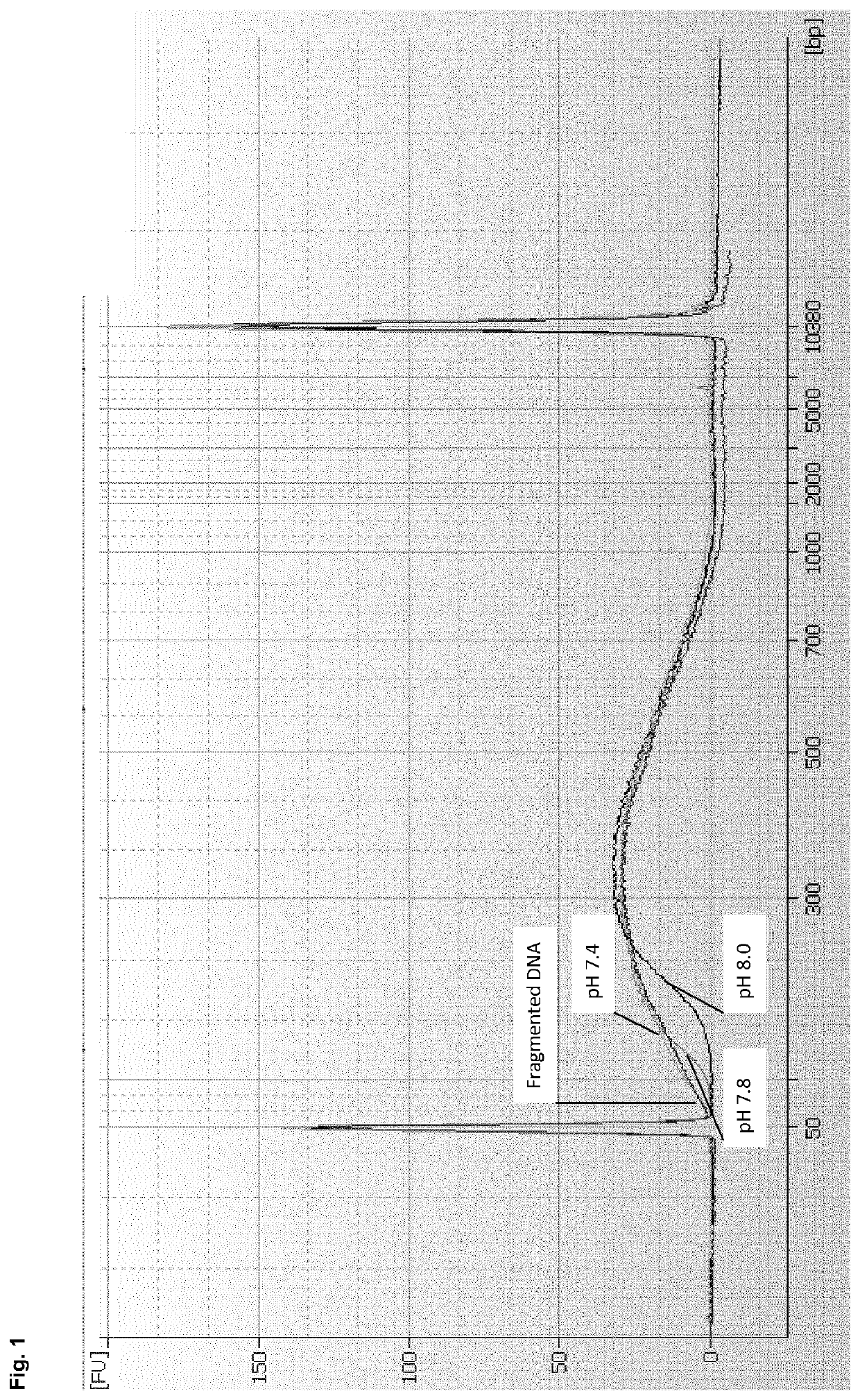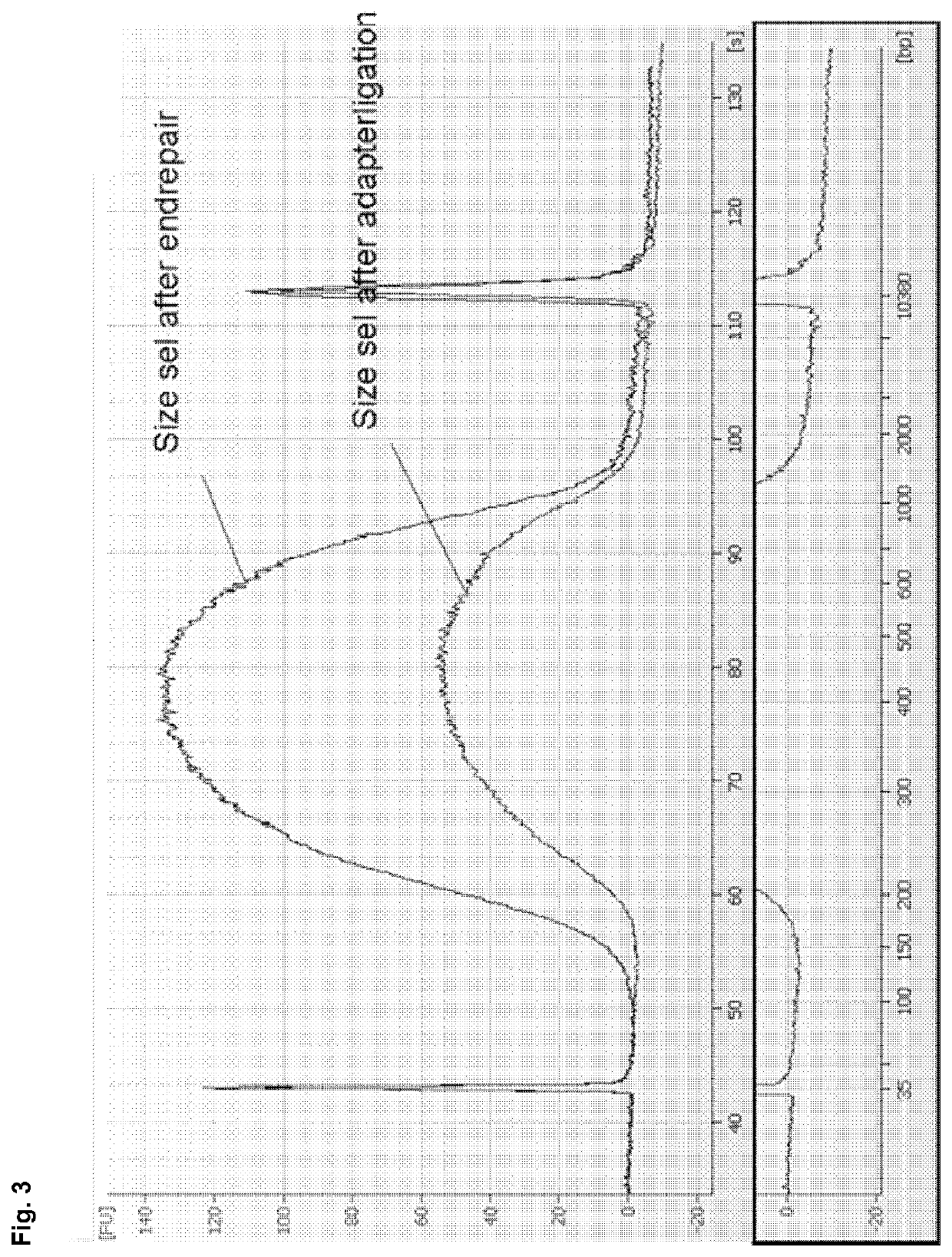Method for separating DNA by size
- Summary
- Abstract
- Description
- Claims
- Application Information
AI Technical Summary
Benefits of technology
Problems solved by technology
Method used
Image
Examples
specific embodiments
[0105]Non-limiting preferred embodiments and applications of the method according to the present invention will now be described in the following. As discussed above, the size selective DNA isolation method according to the present invention is in particular suitable for enriching DNA molecules having a desired length above a certain cut-off value from a mixed population of DNA molecules having different lengths. The method is in particular suitable for removing non-target DNA molecules which have a size below a certain cut-off value by binding and thus isolating target DNA molecules having a desired minimum size above the cut-off value from the DNA containing sample.
[0106]According to one embodiment, the method according to the present invention is performed more than once. Thus, according to one embodiment, at least two size selective DNA isolation cycles using the method of the present invention comprising steps a) to d) are performed. According to one embodiment, the eluate that...
example 1
ctive Removal of DNA-Fragments from Sheared Genomic DNA
[0180]DNA was sheared with the Covaris ultrasonicator in TE buffer to provide a DNA containing sample. 1 volume DNA sample (90 μl) was mixed with 4 volumes of a binding buffer to provide a binding mixture. 3 different binding buffers were tested:[0181]Binding buffer A: 3.5M GTC, 200 mM MOPS, pH 7.4[0182]Binding buffer B: 3.5M GTC, 200 mM MOPS, pH 7.8[0183]Binding buffer C: 3.5M GTC, 200 mM MOPS, pH 8.0
[0184]As can be seen, the binding buffers A to C only differed in their pH value. The obtained binding mixture was spun through a column comprising a silica membrane as binding matrix (QIAquick MinElute spin column (QIAGEN)). The column was washed twice with 80% Ethanol and the DNA was eluted with an elution buffer (10 mM Tris-Cl, pH 8.5).
[0185]The eluates obtained with the binding buffers A to C were analyzed on an Agilent 7500 Chip in order to analyse the cut-off values achieved with the used binding buffers. The results are show...
example 2
TruSeq Library Preparation Using Prior Art Methods or the Invention for Size Selection
[0186]The size selection method according to example 1 was compared with AmPure beads (Beckman-Coulter) based DNA isolation in a TruSeq DNA library preparation workflow for next generation sequencing. DNA from Bacillus subtilis was processed according to the TruSeq DNA Sample Preparation Guide v2 (Illumina) using AMPure beads as described in the handbook (prior art) or by replacing the described AMPure purification steps completely by the method according to the invention (see example 1, using binding buffer C) in order to achieve a cut-off value of 150 bp. A cut-off value of 150 bp is favourable, as adapter monomers (approx. 60 bp) and adapter dimers (approx. 120 bp) can be efficiently removed during size selection. No size selection via gel purification was performed, i.e. size selection of DNA was exclusively performed by using either the AMPure beads based isolation protocol described in the ha...
PUM
| Property | Measurement | Unit |
|---|---|---|
| Fraction | aaaaa | aaaaa |
| Molar density | aaaaa | aaaaa |
| Molar density | aaaaa | aaaaa |
Abstract
Description
Claims
Application Information
 Login to View More
Login to View More - R&D
- Intellectual Property
- Life Sciences
- Materials
- Tech Scout
- Unparalleled Data Quality
- Higher Quality Content
- 60% Fewer Hallucinations
Browse by: Latest US Patents, China's latest patents, Technical Efficacy Thesaurus, Application Domain, Technology Topic, Popular Technical Reports.
© 2025 PatSnap. All rights reserved.Legal|Privacy policy|Modern Slavery Act Transparency Statement|Sitemap|About US| Contact US: help@patsnap.com



